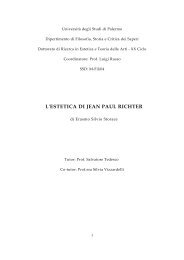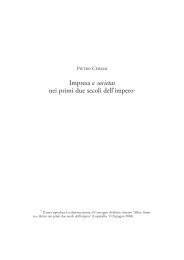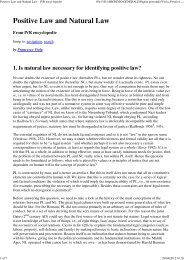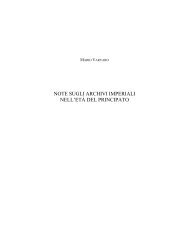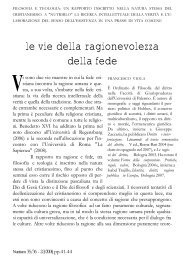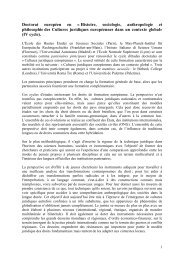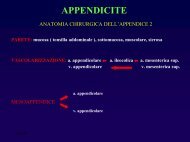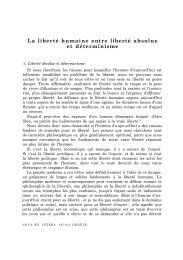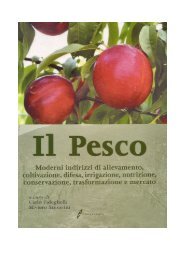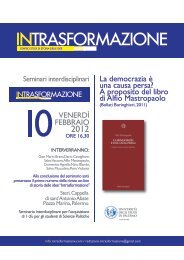M. VARVARO, Gai 4.163 e la struttura della formula arbitraria nell ...
M. VARVARO, Gai 4.163 e la struttura della formula arbitraria nell ...
M. VARVARO, Gai 4.163 e la struttura della formula arbitraria nell ...
Create successful ePaper yourself
Turn your PDF publications into a flip-book with our unique Google optimized e-Paper software.
M. Varvaro, <strong>Gai</strong> <strong>4.163</strong> e <strong>la</strong> <strong>struttura</strong> del<strong>la</strong> formu<strong>la</strong> <strong>arbitraria</strong> [p. 705-734]<br />
tro proceduto ad assolvere il convenuto, senza invitarlo a restituere o a<br />
exhibere. Per ragionare in termini di logica formu<strong>la</strong>re, <strong>la</strong> c<strong>la</strong>uso<strong>la</strong><br />
<strong>arbitraria</strong> esprimeva una condizione (negativa) del<strong>la</strong> condemnatio<br />
direttamente connessa a quel<strong>la</strong> (positiva) espressa nel<strong>la</strong> intentio. Essa,<br />
difatti, non veniva neppure in considerazione ove <strong>la</strong> prima non fosse<br />
stata accertata.<br />
Da questo punto di vista, allora, può dirsi che <strong>la</strong> condizione<br />
contemp<strong>la</strong>ta nel<strong>la</strong> c<strong>la</strong>uso<strong>la</strong> <strong>arbitraria</strong>, dipendendo da quel<strong>la</strong> espressa<br />
nel<strong>la</strong> intentio, differiva da quel<strong>la</strong> contenuta nel<strong>la</strong> exceptio quanto ai<br />
presupposti. Ciò vale a spiegare perché anche dal punto di vista<br />
sintattico <strong>la</strong> exceptio, che enunciava una condizione autonoma rispetto<br />
a quel<strong>la</strong> del<strong>la</strong> intentio, era espressa in una protasi introdotta da<br />
‘SI’ 75 che era del tutto indipendente da quel<strong>la</strong> enunciata <strong>nell</strong>e parti<br />
del<strong>la</strong> formu<strong>la</strong> che <strong>la</strong> precedevano.<br />
Inoltre, <strong>la</strong> condizione contenuta nel<strong>la</strong> exceptio, che riguardava<br />
—————————<br />
75 Si vedano gli esempi di exceptiones testualmente riferiti in <strong>Gai</strong> 4.119 [KRUEGER-<br />
STUDEMUND 7 , 186]: ...SI IN EA RE NIHIL DOLO MALO A. AGERII FACTVM SIT NEQVE FIAT ...<br />
SI INTER A. AGERIVM ET N. NEGIDIVM NON CONVENIT, NE EA PECVNIA PETERETVR; <strong>Gai</strong><br />
4.126 [KRUEGER-STUDEMUND 7 , 188]: ...SI NON CONVENERIT, NE EAM PECVNIAM PETE-<br />
REM. Lo stesso può dirsi per <strong>la</strong> replicatio; v. <strong>Gai</strong> 4.126 [KRUEGER-STUDEMUND 7 ,<br />
188]: ...SI NON POSTEA CONVENIT, VT MIHI EAM PECVNIAM PETERE LICERET. In senso<br />
contrario non varrebbe replicare che anche <strong>la</strong> c<strong>la</strong>uso<strong>la</strong> <strong>arbitraria</strong> poteva essere espressa in<br />
un’autonoma protasi introdotta da ‘SI’, perché nessuna delle citazioni testuali presenti<br />
<strong>nell</strong>e fonti di cui disponiamo suffraga tale ipotesi. D’altra parte, le diverse ricostruzioni<br />
con ‘SI ... NON’ – per cui v., per esempio, A.F. RUDORFF, De iuris dictione edictum, cit. (nt.<br />
6), 71: hereditatis petitio; O. LENEL, EP 3 , cit. (nt. 3), 171: actio Publiciana; 177:<br />
hereditatis petitio; 376 s.: actio aquae pluuiae arcendae – sono state proposte dagli studiosi<br />
senza alcun appiglio testuale sicuro e sono state giustamente ritenute «stilistisch hart» da<br />
parte di M. KASER, Zum Ediktsstil, in Festschrift Fritz Schulz, II, Weimar 1951, 45, nt. 6.<br />
Né appare persuasivo quanto sostenuto in senso contrario, nel discutere appositamente<br />
tale questione, da E. SCHÖNBAUER, Vom Wesen der ‘iudicia <strong>arbitraria</strong>’, cit. (nt. 42), 407,<br />
sul<strong>la</strong> base di quanto si legge in D. 4.2.14.3 (Ulp. 11 ad ed.) con riferimento all’actio furti<br />
manifesti (non statim quadrupli est actio, sed si res non restituatur) e in D. 38.5.5.1 (Paul.<br />
42 ad ed.) con riferimento all’actio Fabiana (in actione Fabiana si res non restituatur, tanti<br />
damnabitur reus, quanti actor in litem iurauerit). Entrambi questi passi del Digesto, infatti,<br />
non tramandano citazioni testuali, ma alludono al<strong>la</strong> condizione espressa nel<strong>la</strong> cosiddetta<br />
c<strong>la</strong>uso<strong>la</strong> <strong>arbitraria</strong> senza che essa sia posta in rapporto con una precedente parte del<br />
programma di giudizio che esprimesse una condizione; sicché si capisce come in questo<br />
contesto, diverso da quello del<strong>la</strong> formu<strong>la</strong>, fosse necessario far cominciare <strong>la</strong> protasi che<br />
esprimeva <strong>la</strong> condizione con un ‘SI’.<br />
732 AUPA 55/2012



